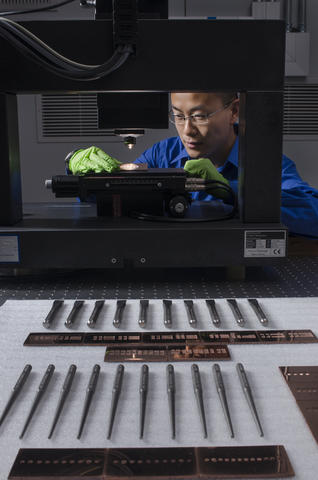FY15 Budget: Measurement Science and Standards for Forensic Science Infrastructure (+$3.5 million)

NIST researcher Alan Zheng uses a 3D disc scanning confocal microscope to examine a chisel toolmark.
The goal of forensic science is to provide the justice system with unbiased, independent scientific analysis and expert testimony. When done well, forensic science helps investigators gather evidence from crime scenes and catch suspects, and it helps the courts correctly determine guilt or innocence.
The challenges facing forensic science were laid out in a 2009 report by the National Research Council of the National Academies (NRC), Strengthening Forensic Science in the United States: A Path Forward. The report noted a lack of uniform standards and peer review of the underlying science across the highly fragmented disciplines of forensic science in the United States.
In response to those and other concerns, NIST and the Department of Justice, in 2013, signed an agreement to improve forensic science through a new National Commission on Forensic Science and a coordinated effort to build a strong infrastructure to develop standards and improve technology for forensic science.
NIST is creating the national Organization of Scientific Area Committees (OSAC), which will replace an existing system of scientific working groups that are funded by a variety of agencies and have different sizes, structures, output and impact within their respective fields. NIST intends to leverage the current ad hoc groups' best practices to standardize activities and output across disciplines.
NIST's own research and development of standard materials, reference data and calibration systems will help to advance measurement quality for forensic science. NIST also has a long history of partnerships with forensic science professional associations, standards development organizations, government, industry and academia.
Proposed NIST Program
NIST requests an increase of $3.5 million, for a total of $11.1 million, to develop science-based standards, measurement methods, tests and validation studies that will underpin reliable, accurate, interoperable and validated forensic analysis.
The work will include the following forensic science disciplines: human identification (DNA, fingerprints, palm prints, face and voice recognition, scars-marks-tattoos, bite marks); controlled substances; trace evidence (microbial identification, fiber, coatings, soil, glass, gunshot residue); toxicology; impression evidence (tire marks, shoe prints, firearms); digital forensics; multimedia forensics (video, audio, images); and fire/arson investigation.
The main emphasis of the planned initiative will be the following:
- Develop, test, evaluate and publish new reference methods and technologies for identifying criminals and understanding crime scenes.
- Develop and apply statistical foundations for forensic science, including uncertainty measurement, error rates, precision, uniqueness, bias and human errors.
- Improve the accuracy, reliability and interoperability of forensic methods, technologies and data through research in underlying science, rigorous testing and methods for assessing conformance to standards.
- Develop calibration systems, reference materials and databases, technology test beds and challenge problems and conduct evaluations in support of reliable and accurate forensic practice.
- Work with national and international standards development organizations, academia, instrument manufacturers, database creators, technology developers and the user communities to encourage adoption of scientifically rigorous and well-characterized standards and practices.
Additional Information
NIST Law Enforcement Standards Office

